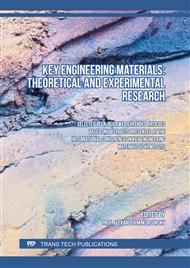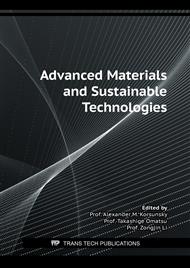[1]
Barakat, M, New trends in removing heavy metals from industrial wastewater. Arabian Journal of Chemistry 4 (4), (2011): 361-377.
DOI: 10.1016/j.arabjc.2010.07.019
Google Scholar
[2]
Boparai H.K., Joseph M., O'Carroll D.M., Kinetics and Thermodynamics of Cadmium Ion Removal by Adsorption onto Nano Zerovalent Iron Particles, J. Hazard. Mater., Vol. 186(1), (2011): 458-465.
DOI: 10.1016/j.jhazmat.2010.11.029
Google Scholar
[3]
Borba, C. E., Guirardello, R., Silva, E. A., Veit, M. T., and Tavares, C. R. G., Removal of nickel (II) ions from aqueous solution by biosorption in a fixed bed column: experimental and theoretical breakthrough curves. Biochemical Engineering Journal, Vol 30(2), (2006). pp.184-191.
DOI: 10.1016/j.bej.2006.04.001
Google Scholar
[4]
Fernandez, G, NORMA OFICIAL MEXICANA NOM-127-SSA1-1994. Estados Unidos Mexicanos (1994).
Google Scholar
[5]
Yu, J.-G., Yue, B.-Y., Wu, X.-W., Liu, Q., Jiao, F.-P., Jiang, X.-Y., & Chen, X.-Q. Removal of mercury by adsorption: a review. Environmental Science and Pollution Research, 23(6), (2016) 5056–5076. https://doi.org/10.1007/S11356-015-5880-X.
DOI: 10.1007/s11356-015-5880-x
Google Scholar
[6]
Huang, S., & Lin, G. Biosorption of Hg(II) and Cu(II) by biomass of dried Sargassum fusiforme in aquatic solution. Journal of environmental health science & engineering, 13, 21 (2015). https://doi.org/10.1186/s40201-015-0180-4.
DOI: 10.1186/s40201-015-0180-4
Google Scholar
[7]
Vijayaraghavan, K., Teo, T. T., Balasubramanian, R., & Joshi, U. M. Application of Sargassum biomass to remove heavy metal ions from synthetic multi-metal solutions and urban storm water runoff. Journal of hazardous materials, 164(2-3), (2009) 1019–1023.
DOI: 10.1016/j.jhazmat.2008.08.105
Google Scholar
[8]
Barquilha, C., Cossich, E.S., Tavares, C., & da Silva, E.A. Biosorption of nickel(II) and copper(II) ions from synthetic and real effluents by alginate-based biosorbent produced from seaweed Sargassum sp. Environmental science and pollution research international, 26(11), (2019) 11100–11112. https://doi.org/10.1007/s11356-019-04552-0.
DOI: 10.1007/s11356-019-04552-0
Google Scholar
[9]
El Financiero. Quintana Roo recibiría hasta un millón de toneladas de sargazo este 2019, Available from: https://elfinanciero.com.mx/peninsula/quintana-roo-recibiria-hasta-un-millon-de- toneladas-de-sargazo-este-(2019).
DOI: 10.32870/sincronia.axxiii.n76.19b19
Google Scholar
[10]
El Universal. Sargazo afecta gran variedad de especies animales y pone en riesgo al Mar Caribe 2019, Available from: https: //www.eluniversal.com.mx/nacion/sargazo-afecta-gran-diversidad-de-especies-animales-y- pone-en-riesgo-al-mar-caribe (2019).
DOI: 10.2307/j.ctv23dxb9m.11
Google Scholar
[11]
Forbes. Gobierno de AMLO invertir 52 mdp para combatir el sargazo 2019, Available from: https://www.forbes.com.mx/asi-es-el-plan-de-52-mdp-para-combatir-el-sargazo-en-quintana-roo.
DOI: 10.20511/usil.thesis/8903
Google Scholar
[12]
Secretaría de Turismo del Gobierno de Quintana Roo. Cancún lidera con el PIB y los empleos por turismo a nivel mundial. Cancun; (2018).
Google Scholar
[13]
Hodson L, Gunn PJ. The regulation of hepatic fatty acid synthesis and partitioning: the effect of nutritional state., Nat Rev Endocrionol 2019;15(12):689-700.
DOI: 10.1038/s41574-019-0256-9
Google Scholar
[14]
Dierge E, Feron O. Dealing with saturated and unsaturated fatty acid metabolism for anticancer therapy. Curr Opin Clin Nutr Metab Care 2019;22(6):427-433.
DOI: 10.1097/mco.0000000000000601
Google Scholar
[15]
Harwood JL. Algae: Critical sources of very long-chain polyunsaturated fatty acids. Biomolecules, 2019; 9(11).
DOI: 10.3390/biom9110708
Google Scholar
[16]
Marangoni F, Agostoni C, Borghi C, Catapano AL, Cena H, Ghiselli A, et al. Dietary linoleic acid and human health: Focus on cardiovascular and cardiometabolic effects., Atherosclerosis 2020; (292): 90-98.
DOI: 10.1016/j.atherosclerosis.2019.11.018
Google Scholar



